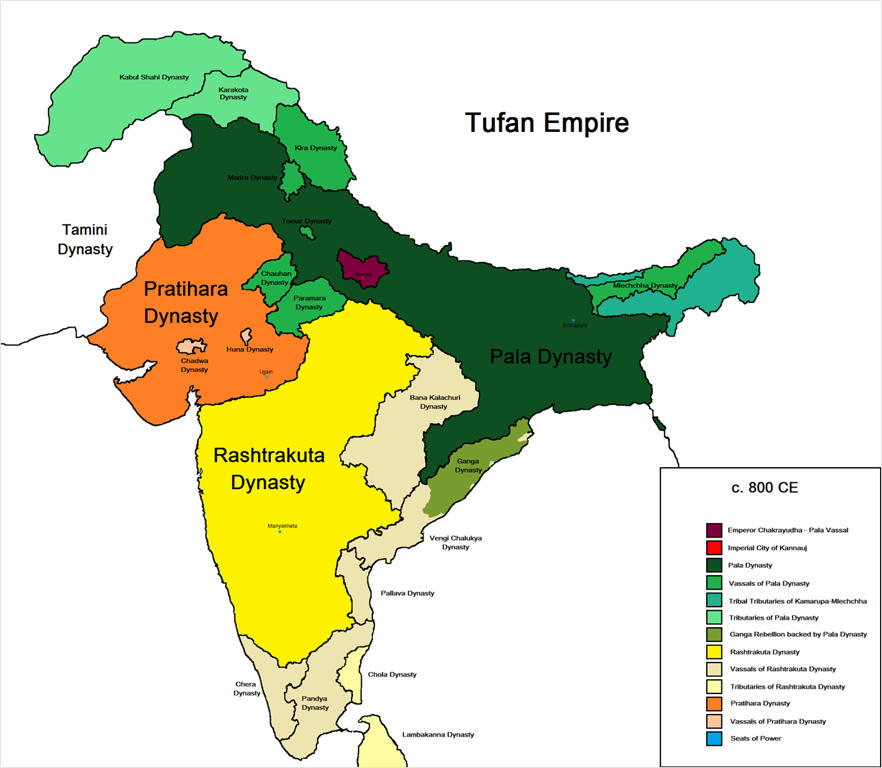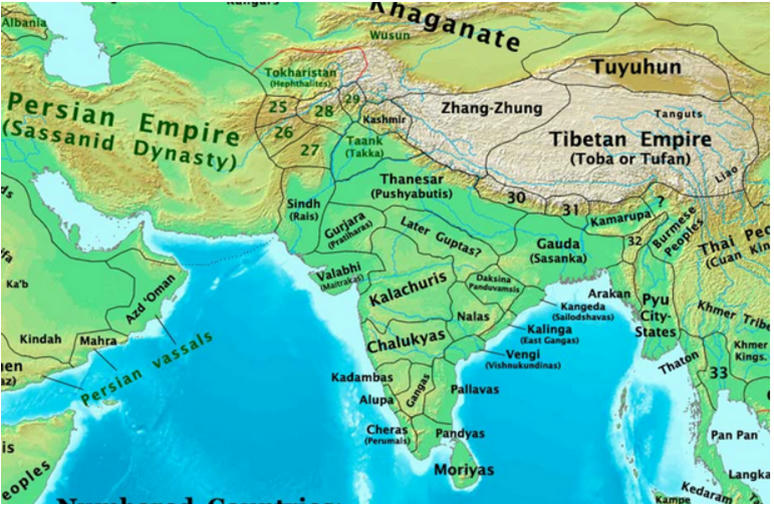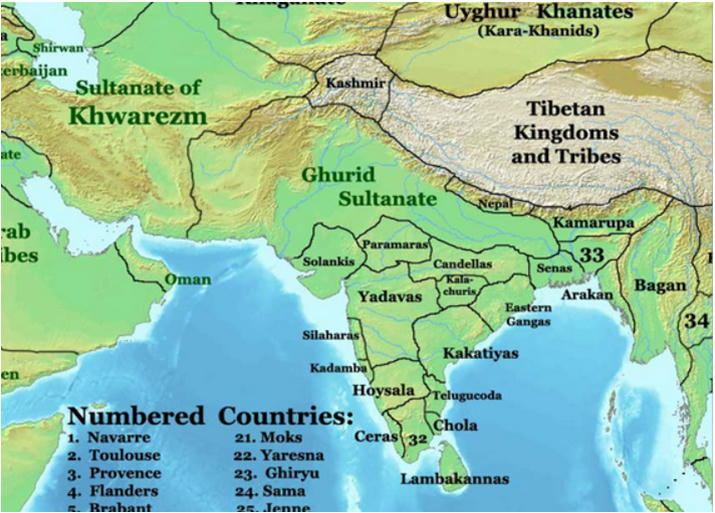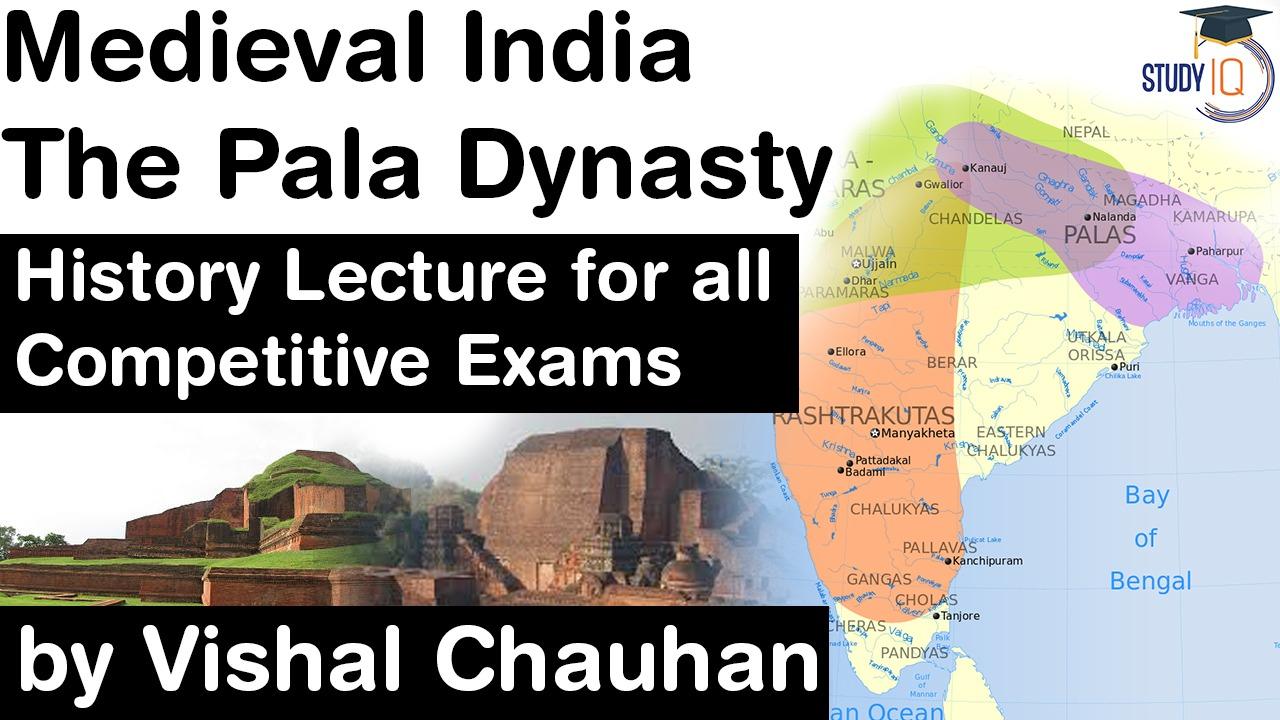Table of Contents
Pala Dynasty:
- The Pala dynasty was founded by Gopala.
- It was asserted by the Khalimpur copper plate of Dharampala( a successor of Gopala).
- The Pala empire was an Imperial power during the late classical period in the Indian subcontinent, which originated in the region of Bengal( modern day Bangladesh and West Bengal).
- It is named after its ruling dynasty, whose rulers bore names ending with suffix of Pala( “protector” in Sanskrit).
- They were followers of the Mahayana and the tantric schools of Buddhism.





- The empire was founded with the election of Gopala as the emperor of Gauda in 750CE.
- The Pala stronghold was located in Bengal and Bihar, which included the major cities of Vikrampura, Patliputra, Gauda, Monghyr, Somapura, Ramavati(Varendra), Tameralipta and Jaggadala.
- The Palas were astute diplomats and military conquerors.
- Their army was noted for its vast war elephant corps.
- Their Navy performed both Mercantile and defensive roles in Bay of Bengal
- They built grand temples and monasteries, including the Somapura mahavihara and patronize the great universities of Nalanda and Vikramsheila
Dharamala( 770-810 CE):
- Dharampala initially got defeated at the hands of Rashtrakutas and Pratiharas, but finally conquered a large part of northern India.
- Bengal and Bihar were the centers of power during his reign, which were under his direct rule.
- The Tibetan tradition believes that the Dharampala was a patron of Buddhism.
- He is accredited to the establishment of the Buddhist monastery at Vikramshila.
Devapala(810-850 CE) and other rulers:
- He was the successor of the Dharampala.
- He was also a patron of Buddhism.
- He made military campaigns to Kamboja(west) and Vindhyas(South) and also exterminated the Utkals and conquered Praygjyotish(Assam).
- In the late 9th century, power of Palas declined.
- The Palas during this time suffered defeat at the hands of Rashtrakutas and Pratiharas.
- The subordinate rulers of Assam and Odisha assumed independence.
- The revival of Pala power happened during the age of Mahipala I.
- However, again the Pala power weakend(Rashtrakuta ruler Indra III defeated Mahipala) and there arose smaller kingdoms in Assam( ruled by Harjarvarman) and Odisha( ruled by the Ganga dynasty).
Decline:
- At its height in the 9th century, the Pala empire was the dominant power in the northern Indian subcontinent, with its territory stretching across parts of modern day eastern Pakistan, northern and northeastern India, Nepal and Bangladesh.
- Empire reached its peak under emperors Dharampal and Devapala.
- The Palas also exerted a strong cultural influence under Atisha in Tibet, as well as in Southeast Asia.

- Pala control of North India was ultimately ephemeral, as they struggled with the Gurjara-Pratiharas and the Rashtrakutas for the control of Kannauj and were defeated.
- After a short lived decline, Emperor Mahipal I defended Imperial bastions in Bengal and Bihar against South Indian Chola invasions.
- Emperor Ramapala was the last strong ruler, who gained control of Kamarupa and Kalingga.
- The empire was considerably weakened by the 11th century, with many areas engulfed in rebellion.
- The resurgent Hindu Sena dynasty dethroned the Pala empire in 12th century, ending the reign of the last major Buddhist Imperial power in the Indian subcontinent.



Significance:
- The Palas brought stability and prosperity to Bengal after centuries of civil war between warring divisions.
- They advanced the achievements of previous Bengali civilizations and created outstanding works of arts, most notably in the sculpture and architectural sphere.
- They laid the basis of the Bengali language, including its first literary work, the Charyapada.
Administration:
- The Pala rule was monarchial.
- The King was the center of all power.
- Pala King would adopt Imperial titles like Parameshwara, Paramvattaraka, Maharadjadiraj.
- Pala Empire was divided into separate Bhuktis( provinces).
- Bhuktis were divided into Vishayas( divisions) and Mandalas( districts).
- Smaller units were Khandala, Bhaga, Avriti, Chaturaka, and Pattaka.
- Administration covered widespread area from the grassroot level to Imperial court.
Architecture:
- Influenced by Gupta art, the Palas school of sculptural art is recognized as a distinct face of the Indian art, and is noted for the artistic genius of the Bengals Sculptors.
- The Palas built a number of monasteries and other sacred structures, including the Somapura Mahavihara in present day Bangladesh a World Heritage site.
- It is a monastery with 21 acres(85000 meters square) complex has 177 cells, numerous stupas, temples and a number of ancillary buildings.
- The gigantic structures of other Viharas, including Vikramshila, Odantpuri, and Jagaddala are the other masterpieces of the Palas.


Tripartite struggle:
- For centuries, rulers belonging to Gurjara-Pratihara, Rashtrakuta and Pala dynasties fought for control over Kannauj.
- Owing to the three parties involved, historians refer to it as a “tripartite struggle”.
- The tripartite struggle for control over Kannauj was fought almost 200 years among the Palas, the Pratiharas and the Rashtrakutas.
- In this tripartite struggle, the Pratihara defeated the Palas and Rashtrakutas.
- In 1018, Kannauj then ruled by Rajayapal Pratihara was sacked by Mahmood of ghazni.
- The Empire broke into independent Rajput states.
- According to contemporary accounts, the Rashtrakutas had the best infantry, the Gurjara-Pratihara had the finest cavalry and the Palas had the largest elephant force.

























 WhatsApp
WhatsApp